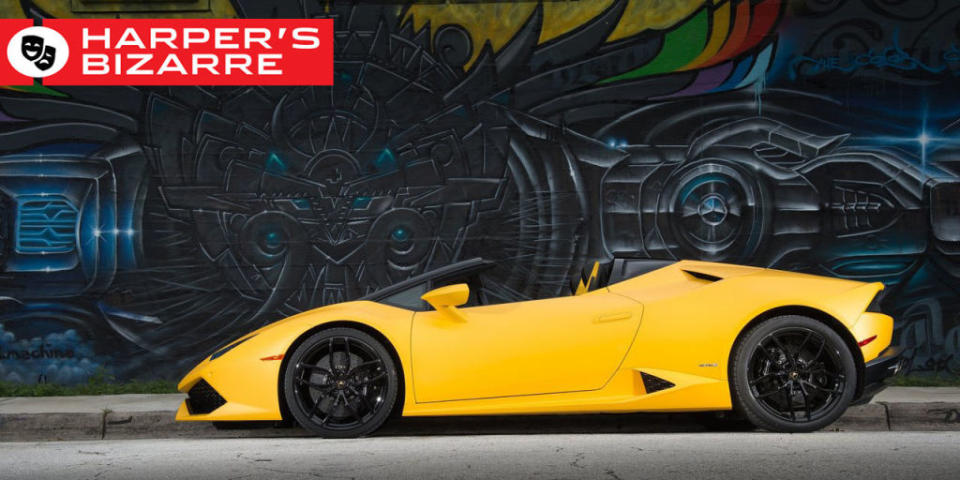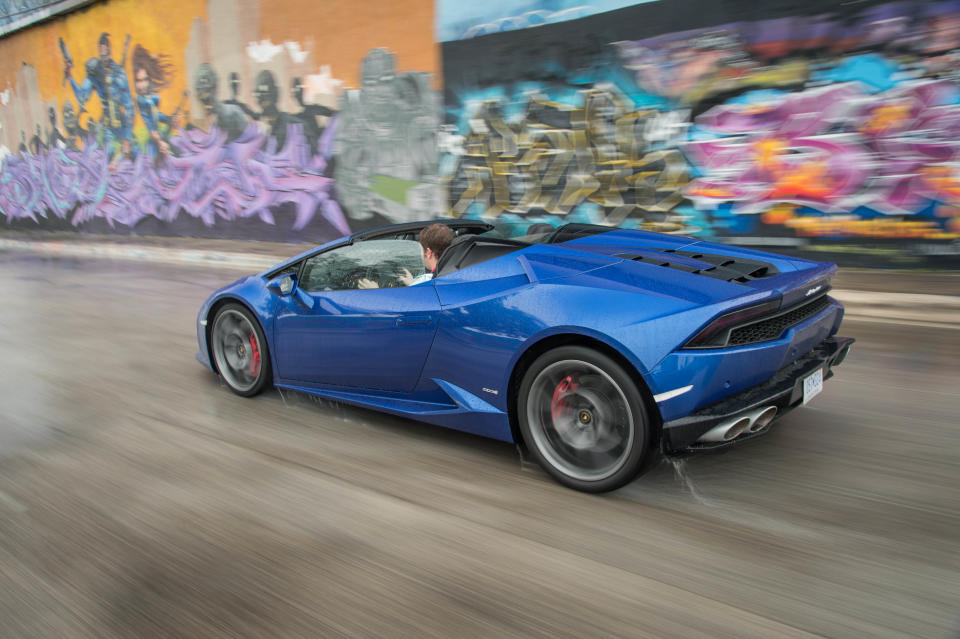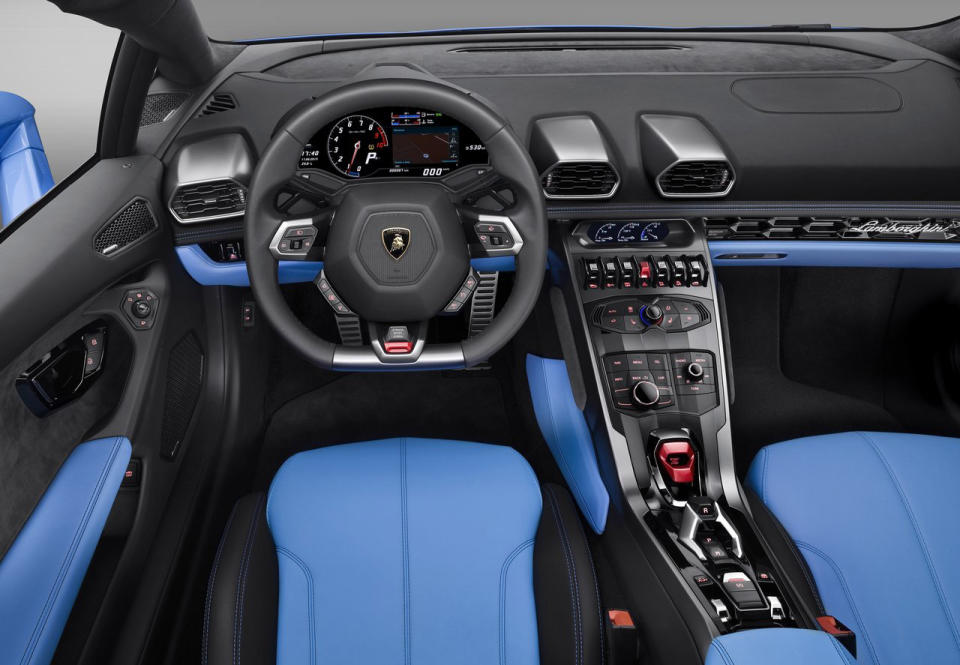Lamborghini Finally Got Everything Perfect With the Huracan Spyder

The Huracan Spyder is the best regular production car that Lamborghini has ever made. When it comes to design and coherent functionality, it even bests its fraternal twin, the Audi R8.
I've driven every major Murcielago/Gallardo and Aventador/Huracan variant released in the last dozen years. Those models were all fast and fun and outrageous, as Lamborghinis must be. Yet there has always been a "but."
But I can't see out the back of the damn thing. But this transmission is asinine. But the Gallardo plows like a potato farmer.
After spending the better part of a week with the brand-new topless version of the Huracan, I couldn't find a conditional "but." Every piece on this machine is worthy of its $262,000 price tag, every element props up its mandate to endlessly entertain the driver and passenger-and anybody else in its visual and aural vicinity.
Road & Track's first drive of the Spyder was in Miami, a place not known for great curving roads. To compound matters, it rained the entire time. And yet website director Travis Okulski still liked it-and he hates convertibles.
We needed more time with it. Given my druthers I always prefer to have a car to myself, on home ground, over consecutive days, to see what I really think of it. To affix my radar detector on the windshield and leave it there. To park the vehicle in my driveway and watch the lines change as the light does. To drive the same roads I drive all the time, and give rides to people whom I either like or want to scare the holy hell out of.
The LP 610-4 Spyder shines because of its details.
Over long hours with the Spyder, my thoughts kept coming back to one salient point. It is coherent in a way that I never expected of a Lamborghini. The LP 610-4 Spyder shines because of its details. It positively resonates with thoughtfulness. It doesn't just rely on the blow-your-face-off exterior or even the blow-your-hair-back acceleration. It's got those things, but they work in tandem with the rest of the car.
Here's some things, in random order, that work really well. Many of which never seemed a consideration in older Lamborghinis.
There's a dead pedal. Your left foot actually fits there. The brake pedal is positioned so that you can easily left- or right-foot brake. The ceramic brakes will haul the car down from big speeds in wonderfully short distances, yet they don't squeak at 20 miles per hour. You can see out the rear even without the backup camera. The AC works. The navigation system works. The stereo works, if you're silly enough to drown out the sound of the V10. And it is all easy to operate. The various buttons and their functions make obvious sense, without taking your eyes off the road for extended periods of time.
And no, none of that is pejorative. This is not the denuded or demystified Lambo. The bull still rages. Because the best part is the mid-mounted, 602-hp V10 engine, resolutely and proudly naturally aspirated. I defy a turbo to deliver this kind of progressive and controllable acceleration and to sound even a third as good.

Lamborghini has been inching toward this achievement for a long time. The final Gallardo models eliminated most of the incessant understeer. Interiors improved. Design director Filippo Perini changed the language of the brand, using negative space and geometric angles rather than just adding on huge wings and gaping vents. The company started looking forward.
Critics will say that these changes are the result of German involvement since it was acquired by the VW Group. To which I'd say they are completely right. A dose of left-brain thinking is welcome, it turns out, especially when the right-brain is still engaged. If the Germans are the ego and the Italians the id, the meshing of the two cultures brings about an excellent supercar.
If the Germans are the ego and the Italians the id, the meshing of the two cultures brings about an excellent supercar.
The interior is better conceived than that of the R8. Audi has long been the master of the hardware and digital mix, but this time they've gone too far out of their way to be clever. Cleverness for cleverness's sake is never a good thing when the goal is to convey complex information at a glance.
Both supercars share a single digital screen in front of the driver, but the R8 is supposed to be a "virtual cockpit." The entire screen changes every time you toggle through a function, including an optional Google Earth map which takes up every bit of the screen. Basic information is often hidden. The steering wheel-mounted controls are tiny and hard to use, and the whole thing is distracting and confusing.
The Lambo has retained the basic functionality and design of the previous Audi MMI system. It's easy to operate and relevant information such as the speedometer, gas gauge, and the odometer are fixed on the screen. Only one portion of the screen changes as you toggle between functions like nav or the stereo. Easy to figure out, easy to read at speed, and you never need to think about its operation ever again.
And the interior is nearly as badass as the exterior. The geometric flourishes on the dashboard look amazing juxtaposed against the old-school toggle switches. The paddle shifters have edges that are almost sharp, a tacit reminder that the machine is dangerous. Controls easily fall easily to the hand and it is all put together beautifully.

How is this all different than the regular AWD coupe and the RWD Huracan LP 580-2? Well, I tested the RWD Huracan, and I loved it. If you're part of the .002 percent who tracks their Lambo regularly, the RWD is the most fun, able to pull off drifts that are the equivalent of a pratfall in a Buster Keaton movie. How did you manage that dangerous stunt and still come out okay?
But you don't want big drifts on a normal road. Take a backcountry lane with trees, ditches, and telephone poles on either side, and you'll likely prefer the LP 610-4's precision. It understeers ever so slightly, but allows you to thread in power early out of corners, yanking you through on an invisible string.
The Spyder is heavier than the coupe (264 pounds), but without having them directly back to back, I couldn't tell. The wonders of a carbon-fiber monocoque anchoring the Ferrari 488 Spider and McLaren 650S and Huracan has transformed the convertible supercar, negating most of the negatives, such as less rigidity. The Huracan Spyder is magnificent fun to ping-pong around back roads in this car with the top down.
One final word: Cars usually get better the longer they are produced. The Spyder has spent longer in development than the coupe, and the overall balance and tuning of the suspension, electronics and fit and finish are a tiny bit better in an undeniable way. I can't say exactly why, but I could feel it overall.
It turns out that a little thoughtfulness puts the topless V10 over the top.
Jason Harper, a contributing editor to Road & Track, has tested and written on cars for two decades. His scariest drive was a rally race in an original Lancia 037, his first drive of a supercar was the Porsche Carrera GT, and the only time he's gotten a speeding ticket was in a base Mini Cooper. His column, Harper's Bizarre, runs every Wednesday.

 Yahoo Autos
Yahoo Autos 